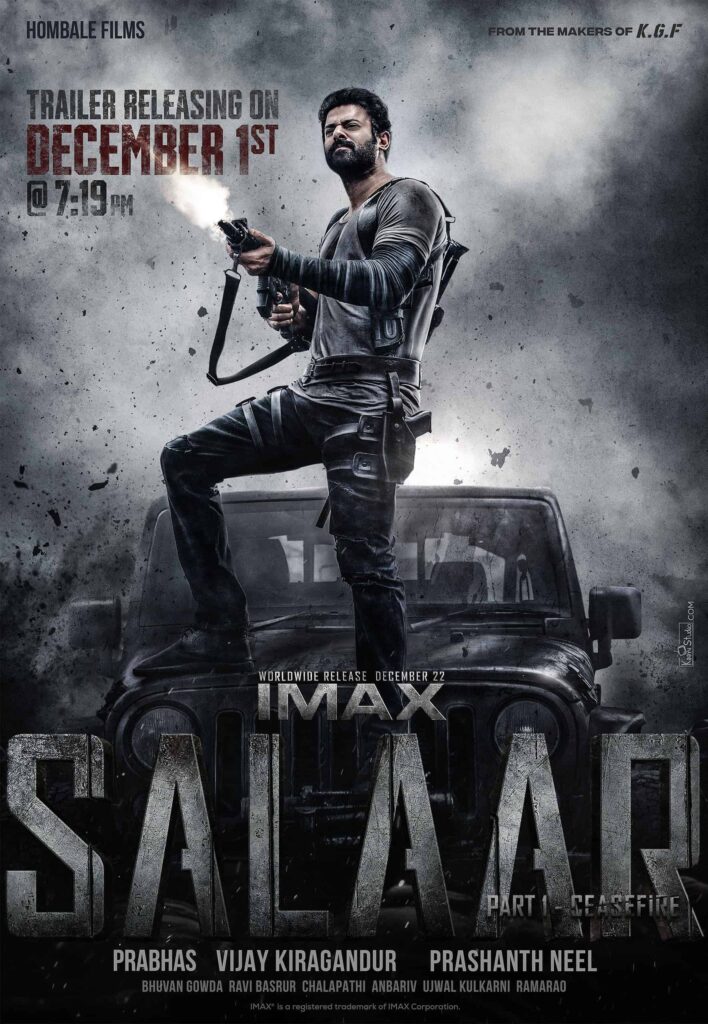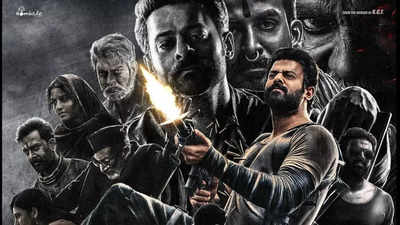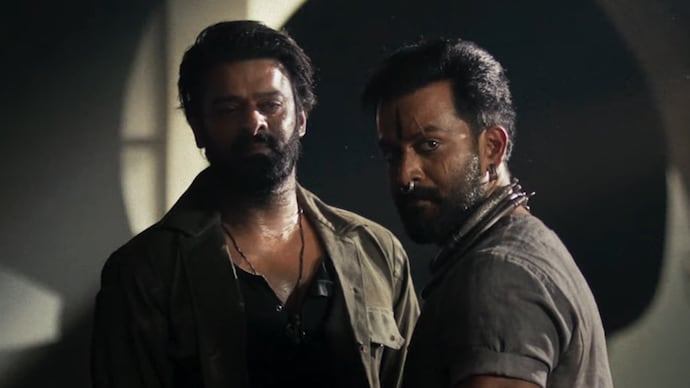
Before dissecting Salaar: Part 1 – Ceasefire (2023) from my point of view, let me begin by sharing a secret with you. You know as a cinephile it’s very much unusual for me to give up on a film before it reaches its conventional ending.
K.G.F: Chapter 1 (2018) was the very first film in my memory when I gave up midway. Maybe it was the bloody violence, maybe it was the strange narrative choices, but something about that film made me not bother proceeding with it further.
Cut to today, this is my maiden experience of viewing a Prashanth Neel film in its entirety. Hence I want you to be patient with me, as I won’t be drawing parallels between this film and the maker’s earlier ventures. Now let us begin our study on the actual subject of Salaar.
Disclaimer: Please stop reading if you haven’t watched the film, yet plan to watch it later on. There’s definitely gonna be spoilers from here on.
The Cast and Characters

What Worked
The Main Leads
The Casting overall is pretty good. Coming to the leading man Prabhas (Devaratha), it was refreshing to see him back in his element. Of course, there still exists the tired, haggard look on him and the languish way in which he delivers his dialogues. But still, his performance here is far superior compared to his other ventures post the Baahubali franchise.
Also as an afterthought, I would add that the slow energy of Prabhas truly works in favour of the film. It can be attributed or seen as part of the pent-up frustration felt by the character of Devaratha for being forced to lead a life similar to that of a fish out of water.
Now talking about the other male lead Prithviraj Sukumaran (Vardha Raja Mannar), overall I enjoyed his performance. But still, I felt he was very much underutilized. As a Keralite who has grown up watching his movies, it was a moment of pride to witness him opposite the towering Prabhas in a pan-Indian film.
Prithviraj always had a knack for playing layered characters at their best. Be it Balachandran from Vaasthavam (2006), or Antony Moses from Mumbai Police (2013), he aced capturing gray shades of his characters. Similarly, Vardha has this aura of a conniving politician within him, hopefully, we’ll get to see more of it in the sequel.
The Female Characters
I once saw Jammypants4 from Tried & Refused Productions predicting Shruti Hassan‘s role in the film to be similar to that of female spectators in the stadiums during cricket tournaments. I would say his analogy proved to be bang-on. There isn’t much for her to do in the film except to play the instrumental catalyst for the audience to better understand the world of Khansaar.
Seriously Shruti’s Aadhya in Salaar reminded me of T.S. Eliot‘s reference to the filament of platinum (catalyst) necessary for the creation of Sulphuric acid from his essay Tradition and Individual Talent (1919).
The portrayal of the other female characters be it Easwari Rao who plays Deva’s mother or Sriya Reddy as Radha Rama Mannar are quite more impactful and interesting despite the limited scope of their roles. However, I still despise the trend of actresses playing mothers to their almost same-age group contemporaries. Really? Is there such a shortage of actors from suitable age groups or is the process of finding them just too tedious for the makers?
Also we literally never get to hear the name of Deva’s mother, there’s no mention of it as far as I know. Isn’t that a bit pathetic? I mean sure she’s a mother and a principal, but that’s about it. But don’t you think a character written as strong-willed as hers deserves a name and identity of her own?
Other Characters
Speaking of others, Tinnu Anand as the loyal Baba, Bobby Simha as the scheming Bhaarava and Jagapathi Babu as the ruthless Raja Mannar were sufficiently good in their respective roles. Though definitely not their best, they did what was necessary for the plot. Also special mention to the child actors who portrayed the main leads wonderfully in the flashback.
What didn’t work
Don’t know about you, but I definitely hated the portrayals of the characters of Ranga and Obulamma. Nothing against the actors John Vijay and Jhansi who played the respective characters. I know the characters are meant to be antagonistic but still the pitch of their execution was way too overdramatic for my taste.
Ranga’s characterization reminded me of Ed from The Lion King (1994). Though human, Ranga has the same infuriating sleazy maniacal energy of a laughing hyena.
Direction and Screenplay

It was refreshing to see Prashanth Neel in Baradwaj Ranjan‘s interview, acknowledging the fact that he chose direction as a profession for the reason of money. Unlike the usual cheesy answers, I was glad that at least someone of his stature had the guts to admit the truth.
Coming to the storyline and direction, I’m actually surprised that I quite enjoyed watching Salaar. I’m aware that some have accused the director of repeating tropes from his earlier works of the K.G.F franchise (2018-22) and Ugramm (2014). But maybe not being familiar with those works added the bonus of freshness on my part.
I am also aware of him being accused of using the repetitive dark tonality of his frames in his films. But here I feel it works genuinely for the Salaar and the world it narrates. The gloaming frames reflect well the grim realities of the world it is set in. The same is the case of violence, Salaar is definitely set in a violent universe. But unlike in K.G.F Chapter 1 where I was appalled by its forceful nature, here it seems to be more content-driven. The non-linear structure also helps in building up the intriguing atmosphere of the film.
The stunts were well executed. I know logic has no place there but some of the set pieces were beautifully staged. One of my biggest gripes about the film would be the presentation of the same clichéd formula of the hero rescuing the distressed women. I mean come on, sure, I am well aware that it’s usually the women and children who get mostly affected in any war. But still, don’t you agree, it’s high time the makers start thinking about some other recipe for accommodating their protagonist’s God syndrome.
The Background Score and Music

I have read certain articles, where some of the fans have apparently expressed dissatisfaction regarding the soundtrack of Salaar. Regardless, for me, it worked perfectly well. Ravi Basrur has done a commendable job.
Often at times when the writing falters, it’s the music that upholds a scene together but in Salaar’s case, the music really compliments well with the soul of its writing. Basrur and Neel surely make a dynamic duo together.
Among the tracks, the sound of salaar is my favourite one. Which one is yours? The songs Sooreede and Prathikadalo, manage to capture and invoke the essential emotions. Special mention for Prathikadalo, for its poignant lyrics penned by Krishna Kanth.
That all said, I wanted to tell you about something in the film that made me laugh. The stuttering sound of a rusty engine is symbolically used as the BGM for Salaar’s hands-tied situation during one of the fight scenes. It was hilarious, I don’t why but maybe it was the creator’s comparison of the character to that of a machine, the whole idea seemed to have produced a comical atmosphere rather than a solemn one.
WTH Moments
Disclaimer: these are strictly personal opinions and are never meant to hurt or disrespect the perspective of others.
- The Curious Case of Khansaar’s Nibandhana or the Constitution: as Raja Mannar says in the film “We are all violent men. Violence is in our blood”, as rightly said Salaar’s canvas explores a world filled with ruthless scheming men. So it becomes pretty ridiculous and unbelievable to think that they are adhering or willing to follow any book or play by its rules as the ultimatum.
- Hawkeyed Amma: here’s me who can’t even see the front gate of my home properly from inside, and then there’s Deva’s mother with her laser-sharp eyesight. No, I am not exaggerating, in the scene where the goons get hold of Aadhya and stamp her with the Khansaar seal, we see Deva’s mother apparently witnessing the whole thing from a moving jeep miles away.
- Mystery of the Mahara Women: this might be just me, but still did you see any male members around the Mahara women? I mean how can there not be at least a single male child or male member be part of any of those families? Also to which tribe do these ladies belong? Mahara is just mentioned as the territory’s name.
- The Drug-Induced Zombies: I mean seriously come on, don’t you agree, isn’t this a bit too much even according to the standards of the movie logic?
- The Chilli Powder Obsession: lastly, who consumes so much red chilli powder with their every meal? Sorry, but seriously I couldn’t resist asking. Was there some sort of metaphor or symbolism involved here? I don’t know, but if you have any theories, please let me know in the comments.
The Verdict

Salaar: Part 1 – Ceasefire (2023), overall I would say for someone who hasn’t yet watched the film you can possibly give it a try. If massive action movies are your thing, then there’s a fair chance that you might enjoy the film. But if you’re allergic to violent films as I was, I would not recommend you to visit this one.
Whether I’ll be looking forward to the sequel? Yes, to some extent I am curious to know especially how Neel manages to stage the two bosom buddies into arch-rivals. Will it be for the throne or for something else?
I also wish we had more time with young charismatic versions of the lead pair. The origin story of the tribes too would have been an interesting watch if extended, but considering the almost three hours running time, it’s a bit too much to ask for now.
Leave a Reply